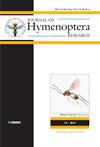An integrative taxonomic study of north temperate Cotesia Cameron (Hymenoptera, Braconidae, Microgastrinae) that form silken cocoon balls, with the description of a new species
IF 1.4
3区 农林科学
Q2 ENTOMOLOGY
引用次数: 0
Abstract
Using CO1 sequence analysis, we investigated the relationships of Western Palearctic and Nearctic Cotesia that spin aggregated cocoons in the shape of a ball, and as adults are morphologically very similar. The analysis included the conceptual taxa C. tibialis, C. ofella, C. vanessae, C. ruficrus, C. xylina and C. yakutatensis, as well as the newly described species C. trivaliaesp. nov. The examined specimens of C. tibialis, C. ofella, C. vanessae, C. ruficrus and C. trivaliaesp. nov. were collected in several European countries, and C. xylina and C. yakutatensis in Canada and the USA. Molecular analyses showed that C. ruficrus is not closely related to the other studied taxa. Based on the genetic distances as well as biology and morphology, C. vanessae and C. ofella are confirmed as solid taxa. The species C. yakutatensis comprises two entities. Having 8 haplotypes, C. tibialis also emerges as a species complex, divided into two clusters. With 26 detected haplotypes, C. xylina shows the highest diversity, being composed of three segregates. The conceptual species C. tibialis, C. xylina and C. yakutatensis seem to be species complexes containing several candidates for recognition as distinct species. One from the European C. tibialis complex is here described as new, and the impediments to be overcome before the description of further species are outlined.对形成丝质茧球的北温带 Cotesia Cameron(膜翅目,腕足动物,微胃肠动物门)进行综合分类研究,并描述一个新物种
利用 CO1 序列分析,我们研究了西古北和近北极地区的 Cotesia 的关系,这些 Cotesia 吐丝结成球状的茧,成虫形态非常相似。分析包括概念类群 C. tibialis、C. ofella、C. vanessae、C. ruficrus、C. xylina 和 C. yakutatensis,以及新描述的物种 C. trivaliaesp.C.tibialis、C. ofella、C. vanessae、C. ruficrus 和 C. trivaliaesp.分子分析表明,C. ruficrus 与所研究的其他类群关系并不密切。根据遗传距离以及生物学和形态学,C. vanessae 和 C. ofella 被确认为固有类群。yakutatensis 包括两个实体。拥有 8 个单倍型的 C. tibialis 也是一个物种复合体,分为两个群。C. xylina 有 26 个检测到的单倍型,显示出最高的多样性,由三个分离体组成。概念种 C.tibialis、C. xylina 和 C. yakutatensis 似乎是一个物种复合体,其中包含几个可被认定为不同物种的候选种。本文将欧洲 C. tibialis 复合物中的一个物种描述为新物种,并概述了在描述更多物种之前需要克服的障碍。
本文章由计算机程序翻译,如有差异,请以英文原文为准。
求助全文
约1分钟内获得全文
求助全文
来源期刊
CiteScore
2.60
自引率
15.40%
发文量
68
审稿时长
>12 weeks
期刊介绍:
The Journal of Hymenoptera Research is a peer-reviewed, open-access, rapid online journal launched to accelerate research on all aspects of Hymenoptera, including biology, behavior, ecology, systematics, taxonomy, genetics, and morphology.
All published papers can be freely copied, downloaded, printed and distributed at no charge for the reader. Authors are thus encouraged to post the pdf files of published papers on their homepages or elsewhere to expedite distribution. There is no charge for color.

 求助内容:
求助内容: 应助结果提醒方式:
应助结果提醒方式:


